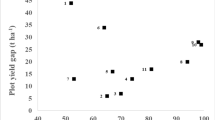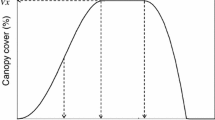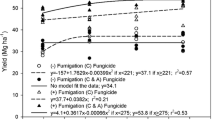Abstract
For organic potato producers the two main challenges are disease and nutrient management. Both factors are limited by regulations that on the one hand prohibit the use of chemical fertilisers, especially nitrogen and, on the other hand, most synthetic pesticides. Late blight, caused by Phytophthora infestans is commonly thought to be the factor most limiting yield. However, because there is no really effective fungicide available to control late blight, there are virtually no yield loss data available for organic farming conditions. In this paper the state of the art of organic potato management with respect to disease and nutrient management is summarised. In a second part, the interactive effects of N-availability in the soil, climatic conditions and late blight were studied in the presence and absence of copper fungicides from 2002–2004 for the mid-early main-crop potato cv. Nicola. From the experimental work it became clear that copper fungicides in most cases do slow down epidemics adding an average of 3 days to the growth duration. However, only 30% of the variation in yield could be attributed to disease reduction. A model including disease reduction, growth duration and temperature sum from planting until 60% disease severity was reached, and soil mineral N contents at 10 days after emergence could explain 75% of the observed variation in yield. However, the model failed when N-supply was extremely high. The implications of the results on the management of organic potatoes with respect to cultivar choice, nutrient and disease management are discussed. In conclusion, several points emerge from the results: In organic farming, yields are foremost limited by nutrient availability in spring and early summer. The effects of late blight on yields may often be overestimated and cannot be deducted from results in conventional farming because of the strong interaction with nutrient status. Resistance clearly remains the most important strategy against late blight in organic potato production. However, as important or even more important than resistance is the early development and bulking behaviour and the ability of a cultivar to make use of organic nutrients efficiently. In the absence of efficient organic pesticides it is possible to reduce blight pressure to a certain extent by arranging the crop in small narrow fields perpendicular to the main wind direction neighboured either by non-hosts or completely resistant potatoes.
Similar content being viewed by others
Abbreviations
- AUDC:
-
area under the disease progress curve
- Days:
-
growth duration (days) from planting until 60% diseased leaf area
- N10:
-
N-min at day 10 after emergence
- N21:
-
N-min at day 21 after emergence
- Ttot:
-
temperature sum: sum of daily mean temperatures from planting until 60% diseased leaf area
- Disred:
-
disease reduction: AUDC with copper application divided by AUDC without copper application
References
Alloway BJ (1995) Heavy metals in soils, 2nd edn. Blackie Academic and Professional, London
Andrivon D, Lucas J, Ellisseche D (2003) Development of natural late blight epidemics in pure and mixed plots of potato cultivars with different levels of partial resistance. Plant Pathol 52:586–94
Bouws-Beuermann H (2005) Effects of strip intercropping on late blight severity, yields of potatoes (Solanum tuberosum Lindl.) and on population structure of Phytophthora infestans. Dissertation, University of Kassel
Bruns C, Finckh MR, Dlugowski S, Leifert C, Hospers M (2003) Interaction between soil fertility management and varity specific characteristics with the infestation of potatoes with Phytophthora infestans. In: Freyer B (ed) Ökologischer Landbau der Zukunft. Beiträge zur 7. Wissenschaftstagung zum Ökologischen Landbau. Ökologischer Landbau der Zukunft, 24–26 Feb 2003, Wien. Institut für ökologischen Landbau an der Universität für Bodenkultur, Vienna, pp 145–148, www.orgprints.org/966/
Döring TF, Brandt M, Heß J, Finckh MR, Saucke H (2005) Effects of straw muluch on soil nitrate dynamics, weeds, yield and soil erosion in organically grown potatoes. Field Crops Res 94:249
Finckh MR, Andrivon D, Borgatti S, Bouws-Beuermann H, Corbière R, Engström K, Phillips S, Wolfe MS (2003) Diversification strategies for the management of potato late blight. In: Freyer B (ed) Beiträge zur 7. Wissenschaftstagung zum Ökologischen Landbau. Ökologischer Landbau der Zukunft, 24–26 Feb 2003, Wien. Institut für ökologischen Landbau an der Universität für Bodenkultur, Vienna, pp 141–144, www.orgprints.org/1937/
Finckh MR, Bouws-Beuermann H, Piepho HP, Büchse A (2004) Auswirkungen von Streifenanbau und Ausrichtung zum Wind auf die räumliche Verteilung und epidemiologische Parameter der Kraut-und Knollenfäule. Mitt Bio Bundesanst Land-Forstwirtsch 396:515–516
Garett KA, Mundt CC (2000) Host diversity can reduce potato late blight severity for focal and general patterns of primary inoculum. Phytopathology 90:1307–1312
Gruber H, Thamm U, Michel V (2003) Effektive Nutzung des Leguminosenstickstoffs in der Fruchtfolge [Effective use of Legume Nitrogen in the Crop Rotation]. Ökol Landbau 127:29–31
Haase T, Schüler C, Kölsch E, Heß J, Haase NU (2005) Einfluss von Düngung und Sorte auf Ertrags- und Qualitätsparameter von Verarbeitungskartoffeln im Ökologischen Landbau. In: Heß J, Rahmann G (eds) Ende der Nische. Beiträge zur 8. Wissenschaftstagung zum Ökologischen Landbau, 1–4 March 2005, Kassel. Kassel University Press, Kassel, pp 51–54, www.orgprints.org/3831/
Harris PL (1992) The potato crop-the scientific basis for improvement, 2nd edn. Chapman & Hall, London
James C (1971) A manual of assessment keys for plant diseases. Am Phytopathological Soc, ASP Press, St. Paul, MN
Kainz M, Möller K (2003) Ansätze zur Reduzierung der Kupferaufwandmenge im ökologischen Kartoffelbau. In: Freyer B (ed) Ökologischer Landbau der Zukunft. Beiträge zur 7. Wissenschaftstagung zum Ökologischen Landbau. Ökologischer Landbau der Zukunft, 24–26 Feb 2003, Wien. Institut für ökologischen Landbau an der Universität für Bodenkultur, Vienna, p 553
Karalus W, Rauber R (1997) Effect of presprouting on yield of maincrop potatoes (Solanum tuberosum) in organic farming. J Agron Crop Sci 179:241–249
Karalus W (2000) Qualitätsminderung durch Rhizoctonia solani vermeiden. Infodienst 3/00:53–56
Kranz J (1996) Epidemiologie der Pflanzenkrankheiten. Eugen Ulmer Verlag, Stuttgart
Marschner H (1995) Mineral nutrition for higher plants, 2nd edn. Academic Press, London
Millard P, MacKerron DKL (1986) The effects of nitrogen application on growth and nitrogen distribution within the potato canopy. Ann Appl Biol 109:427–437
Möller K (2000) Einfluß und Wechselwirkung von Krautfäulebefall (Phytophthora infestans (Mont.) de Bary) und Stickstoffernährung auf Knollenwachstum und Ertrag von Kartoffeln (Solanum tuberosum L.) im Ökologischen Landbau. Technical University of Munich, Munich
Möller K, Meinck S (2003) Phythophtora infestans der Erreger der Kraut- und Knollenfäule. In: Möller K, Kolbe H, Böhm H (eds) Handbuch Ökologischer Kartoffelbau. Österreichischer Agrarverlag, Leopoldsdorf, pp 105–114
Musa-Steenblock T, Forrer H-R (2005) Bio-PhytoPRE-a decision support system for late blight control in organic potato production in Switzerland. In: Heß J, Rahmann G (eds) Ende der Nische. Beiträge zur 8. Wissenschaftstagung zum Ökologischen Landbau, 1–4 March, 2005, Kassel. Kassel University Press, Kassel, pp 133–136, http://www.orgprints.org/3211
Müller T, von Fragstein und Niemsdorff P (2005) Vegetabile Düngemittel N-Umsatz im Boden bei Inkubationsexperimenten und in Feldversuchen. In: Heß J, Rahmann G (eds) Ende der Nische. Beiträge zur 8. Wissenschaftstagung zum Ökologischen Landbau, 1–4 March, 2005, Kassel. Kassel University Press, Kassel, pp 205–208
Neuhoff D (2000) Speisekartoffelerzeugung im Organischen Landbau—Einfluß von Sorte und Rottemistdüngung auf Ertragsbildung und Knolleninhaltsstoffe. Landwirtschaftliche Fakultät der Universität Bonn
Neuhoff D, Klinkenberg H-J, Köpke U (2003) Nutzung von Pflanzenextrakten zur Kontrolle der Krautfäule (P. infestans) im ökologischen Kartoffelbau [Plant extracts for late blight (Phytophthora infestans) control in potatoes]. In: 7. Wissenschaftstagung Ökologischen Landbau "Ökologischer Landbau der Zukunft", Wien, 24–26 Febuary, 2003. Institut für ökologischen Landbau an der Universität für Bodenkultur, Vienna, pp 559–560
Paffrath A (2002) Drahtwurmbefall an Kartoffeln. Bioland 2002:23
Radtke W, Riekmann W, Brendler F (2000) Kartoffel, Krankheiten, Schädlinge, Unkräuter. Verlag Th. Mann, Gelsenkirchen Buer
Raupp J (2005) Stickstoffmineralisation von Stallmist, Ackerbohnenschrot, Luzernegrünmehl und Rizinusschrot unter kontrollierten Bedingungen im Brutversuch. In: Heß J, Rahmann G (eds) Ende der Nische. Beiträge zur 8. Wissenschaftstagung zum Ökologischen Landbau, 1–4th March, 2005, Kassel University Press, Kassel, pp 219–220
SAS (1988) Statistical Analysis Systems SAS/STAT Users Guide, 6.04 edn. SAS Institute Inc., Cary, NC
Saucke H, Döring TF (2004) Potato virus Y reduction by straw mulch in organic potatoes. Ann Appl Biol 144:347–55
Schepl U, Paffrath A (2003) Entwicklung von Strategien zur Regulierung des Drahtwurmbefalls (Agriotes spp. L.) im ökologischen Kartoffelanbau [The Development of Strategies to Regulate the Infestans of Wireworms (Agriotes spp. L.) in Organic Potato Farming]. In: Freyer B (ed) Ökologischer Landbau der Zukunft, Beiträge zur 7. Wissenschaftstagung zum Ökologischen Landbau. Institut für ökologischen Landbau an der Universität für Bodenkultur, Vienna, pp 133–136
Schinner F, Öhlinger R, Kandeler E (1996) Methods in soil biology, 2nd edn. Springer, Berlin, Heidelberg, New York
Schliephake U, Trautz D, Grimm J (2001) Einsatz verschiedener Mittel zur Regulierung der Krautfäule (Phytophthora infestans) an Kartoffeln (Sorte Linda). In: Reents HJ (ed) Beiträge zur 6 Wissenschaftstagung zum Ökologischen Landbau, 6–8th March, 2001 in Freising. Weihenstephan Verlag Dr. Köster, Berlin, pp 381–384
Stefan D, Schmitt A, Koch E (2003) EU—Projekt—Development of a systems approach for the management of late blight in EU organic potato production. In: Kühne S, Britta F (eds) Pflanzenschutz im Ökologischen Landbau—Probleme und Lösungsansätze. Berichte aus der Biologischen Bundesanstalt für Land- und Forstwirtschaft, Heft 118. Saphir Verlag, Ribbesbüttel, Germany, pp 67–69
Stevenson WR (1993) Management of early blight and late blight. Am Phytopathological Soc, ASP Press, St. Paul, MN, pp 141–147
Tamm L, Smit AB, Hospers M, Janssens SRM, Buurma JS, Molgaard JP, Laerke PE, Hansen HH, Hermans A, Bodker L, Bertrand C, Lambion J, Finckh MR, van Lammerts CE, Ruissen T, Nielsen BJ, Solberg S, Speiser B, Wolfe MS, Phillips S, Wilcoxon SJ, Leifert C (2004) Assessment of the socio-economic impact of late blight and state-of-the-art management in European organic potato production systems, FiBL Report. Research Institute of Organic Agriculture FiBL, Frick, Switzerland, p 106, www.orgprints.org/2936
Van Delden A (2001) Yield and growth of potato and wheat under organic N-Management. Agronomy J 93:1370–1385
Van der Zaag DE (1992) Potatoes and their cultivation in the Netherlands. NIVAA (Netherlands Potato Consultative Institute), www.potato.nl
Vos J (1995) Nitrogen and the growth of potato crops. In: Haverkort AJ, MacKerron DKL (eds) Potato ecology and modelling of crops under conditions limiting growth. Kluwer, Dordrecht, pp 115–128
Wright I (2002) Nutritition, Blight and Skin Finish in Early Potato Production-Organic Advisory Service Organic Early Potato Production in Devon. A HDRA event, venue Beesands near Kingsbride, South Devon. Rep. EU project QLK-CT-2000-01065 BLIGHT-MOP, Workshop report
Author information
Authors and Affiliations
Corresponding author
Rights and permissions
About this article
Cite this article
Finckh, M.R., Schulte-Geldermann, E. & Bruns, C. Challenges to Organic Potato Farming: Disease and Nutrient Management. Potato Research 49, 27–42 (2006). https://doi.org/10.1007/s11540-006-9004-3
Accepted:
Published:
Issue Date:
DOI: https://doi.org/10.1007/s11540-006-9004-3




